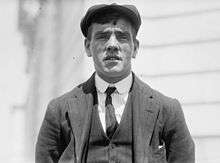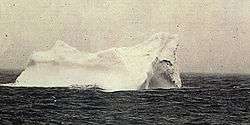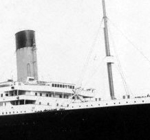Frederick Fleet
| Frederick Fleet | |
|---|---|
 Frederick Fleet at age 24, 1912. | |
| Born |
15 October 1887 Liverpool, England, UK |
| Died |
10 January 1965 (aged 77) Southampton, England, UK |
| Nationality | British |
| Occupation | Sailor, Crewman |
Frederick Fleet (15 October 1887 – 10 January 1965) was a British sailor, crewman and survivor of the sinking of the RMS Titanic after it struck an iceberg on 14 April 1912.[1] Employed as a lookout aboard the Titanic, it was Fleet who first sighted the iceberg, ringing the bridge to proclaim, "Iceberg, right ahead!"[2] Fleet testified at the inquiries that if he had been issued with binoculars, "We could have seen it a bit sooner." When asked how much sooner, he responded, "Well, enough to get out of the way." [3] In later life, Fleet suffered severe depression, and died by suicide.
Biography
Early life and sea career
Fleet was born in Liverpool on 15 October 1887. He never knew his father, and his mother abandoned him and fled with a boyfriend to Springfield, Massachusetts, in the United States never to be seen or heard from again.[4] Frederick was raised by a succession of foster families and distant relatives. In 1903 he went to sea as a deck boy, working his way up to able seaman.[5]
Before joining the crew of the RMS Titanic he had sailed for over four years as a lookout in the RMS Oceanic.[5] As a seaman, Fleet earned five pounds per month plus an extra 5 shillings for lookout duty.[5] And it was as a lookout that Fleet joined the Titanic in April 1912, along with five other watchmen.[5]
R.M.S. Titanic


Fleet boarded the Titanic in Southampton on 10 April 1912. The ship made two stops, first in Cherbourg, France and Queenstown, in Ireland. The lookouts, six in total, made two-hour shifts due to extreme cold in the crow's nest.[6] The trip was uneventful until the night of 14 April 1912. At 22:00 (10PM) that night, Fleet and his fellow lookout Reginald Lee replaced George Symons and Archie Jewell at the nest.[7] They passed on the order given earlier to them by second officer Charles Lightoller to watch out for small ice.[8] The night was calm and moonless, which made it difficult to spot the icebergs due to the lack of waves breaking against the base of the iceberg and reflection.[9] Furthermore, despite repeated requests for binoculars, they were not available for the lookouts. It is sometimes attributed to the last-minute change in the hierarchy of the ship when officer David Blair was replaced by Henry Tingle Wilde, without Blair mentioning where the binoculars had been located. It has been also mentioned that Blair accidentally took the keys of the cabinet containing the binoculars with him.[10] Despite both inquiries into the disaster, nothing clarified why the lookouts were not provided with binoculars, though there are many explanations such as one that the White Star Line steamers' lookouts did not particularly use them.[11] Besides, some experts have said that even using binoculars, neither Fleet nor Lee could have spotted the iceberg any sooner given the conditions of the night.[12]
At 23:40 (11:40PM), Fleet first spotted the iceberg and rang the nest's bell three times to warn the bridge of something ahead. Then, using the nest's telephone he pronounced the infamous "Iceberg! Right Ahead!" warning to sixth officer James Paul Moody who immediately notified first officer William McMaster Murdoch; in charge of the bridge.[13] After the collision, Fleet and Lee remained on duty for twenty more minutes.[14]
At 00:00 (12AM), Fleet and Lee were relieved by Alfred Frank Evans and George Hogg.[15]

Fleet went down to boat deck and helped to prepare Lifeboat No. 6. Minutes later, when the boat was already prepared, second officer Lightoller put quartermaster Robert Hichens in charge of the lifeboat and ordered Fleet aboard as well.[14] As they were lowered away, Hichens and American socialite Margaret Brown realized there were only two sailors to man the boat, including Fleet and called for another sailor to be sent.[16] As no able seaman was near, Canadian Colonel Arthur Godfrey Peuchen volunteered to join the boat saying he had experience in sailing. He was ordered by Lightoller to reach the boat by climbing down a rope, which he did successfully.[16]
Once away from the sinking ship, the boat tried to reach the lights of a ship in the distance, thought to be the SS Californian.[17] While Hichens remained at the tiller, Fleet and Peuchen managed the oars. Arguments and problems arose on boat 6 as quartermaster Hichens kept insulting and mistreating the rowers, including Margaret Brown and Helen Churchill Candee. Later in the night, there was an argument on whether to return for survivors, with Hichens warning against returning saying they would be swamped by swimmers.[18] The boat finally reached the RMS Carpathia by 6:00AM on Monday, 15 April 1912.[19]
After the disaster, Fleet underwent two inquiries; first, the U.S. Inquiry and then the British Wreck Commissioner's inquiry. In the United States, he was inquired by Senator William Alden Smith, to whom he repeatedly said that had they been equipped with binoculars, the disaster wouldn't have happened.[2] Before the British Inquiry, he underwent a long examination, often repetitive, for which he refused to answer many of the questions. Lord Mersey, Chairman of the Commission concluded Fleet's interrogation by telling him that he was grateful for his willingness to answer questions despite his wariness when responding to every question. Fleet replied with a sarcastic "Thanks."[20]
World Wars and later life
Fleet served in the Titanic's sister ship RMS Olympic before leaving the White Star Line in August 1912 after noticing that the company treated those involved with the Titanic differently - in an attempt to forgive what had happened.[21] For the next 24 years he sailed for different shipping companies, including the Union-Castle Line. Fleet served on merchant ships throughout World War I. Later, he was the ship's lookout on the RMS Oceanic, during the 1920s and early 1930s.[14] When he left the sea in 1936, he was hired by Harland & Wolff to work at the company's shipyards in Southampton.[22] While working there, he lived with his wife's brother. He served again during World War II.[14]
Later, when he was about to retire, he became a newspaper seller, going through difficult economic times.[22]
Death
Shortly after Christmas, on 28 December 1964, Fleet's wife died, and her brother evicted him from the house.[23] Fleet fell into a downward spiral into depression and hanged himself in the house's garden on 10 January 1965.[23] Fleet was buried in a pauper's grave at Hollybrook Cemetery, in Southampton. The grave went unmarked until 1993, when a headstone bearing an engraving of the Titanic was erected through donations by the Titanic Historical Society.[23][24]
On the 100th anniversary of the R.M.S. Titanic disaster, an incident occurred at Fleet's grave where commemorative centenary wreathes were illicitly removed and replaced with a pair of binoculars by person(s) unknown, along with the binoculars was left a comedic note referring to the absence of the instrument from Fleet's possession on the night of 14 April 1912. The incident was condemned by the British Titanic Society.[25][26]
External links
| Wikimedia Commons has media related to Frederick Fleet. |
- Frederick Fleet Encyclopedia Titanica biography
- Frederick Fleet Titanic Pages biography
- Frederick Fleet at Find a Grave
References
- ↑ Fleet was second-in-charge aboard lifeboat #6
- 1 2 United States Senate Inquiry Day 4, Testimony of Frederick Fleet.
- ↑ http://www.titanicinquiry.org/USInq2/AmInq04Fleet02.php
- ↑ Spignesi, Stephen J. (January 2012). The Titanic For Dummies. John Wiley & Sons. p. 118. ISBN 978-1-118-17766-2.
- 1 2 3 4 Stories from The Titanic, National Archives UK.
- ↑ Golden, Frank; Tipton, Michael (June 2002). Essentials of Sea Survival. Human Kinetics Pub Inc. p. 12. ISBN 978-0-7360-0215-8.
- ↑ Matthews, Rupert (March 2011). Titanic: The Tragic Story of the Ill-fated Ocean Liner. Arcturus Publishing. ISBN 1-84837-763-0.
- ↑ Spignesi, Stephen J. (January 2012). The Titanic For Dummies. John Wiley & Sons. p. 86. ISBN 978-1-118-17766-2.
- ↑ Angel, Simon (April 2012). The Titanic - "Everything Was Against Us". CreateSpace Independent Publishing Platform. p. 53. ISBN 978-1-4751-2793-5.
- ↑ Is this the man who sank the Titanic by walking off with vital locker key?, Daily Mail.
- ↑ Maltin, Tim; Aston, Eloise (November 2011). 101 Things You Thought You Knew about the Titanic - But Didn't!. Penguin Books. p. 33. ISBN 978-0-14-311909-8.
- ↑ 10 causes of the Titanic tragedy, NBC news.
- ↑ Spignesi, Stephen J. (January 2012). The Titanic For Dummies. John Wiley & Sons. p. 304. ISBN 978-1-118-17766-2.
- 1 2 3 4 Fred Fleet did his duty on Titanic, now resting in peace, Herald Dispatch.
- ↑ Kuntz, Tom (October 2010). The Titanic Disaster Hearings. Gallery Books. p. 184. ISBN 978-1-4516-2347-5.
- 1 2 Brewster, Hugh (March 2012). Gilded Lives, Fatal Voyage: The Titanic's First-Class Passengers and Their World. Crown (publisher). ISBN 978-0-307-98481-4.
- ↑ Lord, Walter (March 2013). The Complete Titanic Chronicles: A Night to Remember and The Night Lives On. Open Road Media. ISBN 978-1-4804-1058-9.
- ↑ Spignesi, Stephen J. (January 2012). The Titanic For Dummies. John Wiley & Sons. p. 51. ISBN 978-1-118-17766-2.
- ↑ Shapiro, Marc (May 2013). Total Titanic. Boylston Multimedia. ISBN 978-0-671-01202-1.
- ↑ Chirnside, Mark (2004). The 'Olympic' class ships : Olympic, Titanic, Britannic. Tempus. pp. 206, 207. ISBN 978-0-7524-5895-3.
- ↑ Hooper McCarty, Jennifer; Foecke, Tim (February 2008). What Really Sank the Titanic. Citadel; 1 edition. p. 230. ISBN 978-0-8065-2895-3.
- 1 2 Spignesi, Stephen J. (January 2012). The Titanic For Dummies. John Wiley & Sons. p. 47. ISBN 978-1-118-17766-2.
- 1 2 3 Frederick Fleet(1887–1965), Maritime Quest.
- ↑ Frederick Fleet biography, www.biography.com.
- ↑ "Sorry for bringing these 100 years too late": Sick pranksters leave binoculars on grave of Titanic lookout, Mirror.co.uk.
- ↑ Pranksters 'desecrate' grave of Titanic lookout ... by laying binoculars under headstone and note saying: 'Sorry they're 100 years too late.', Daily Mail.